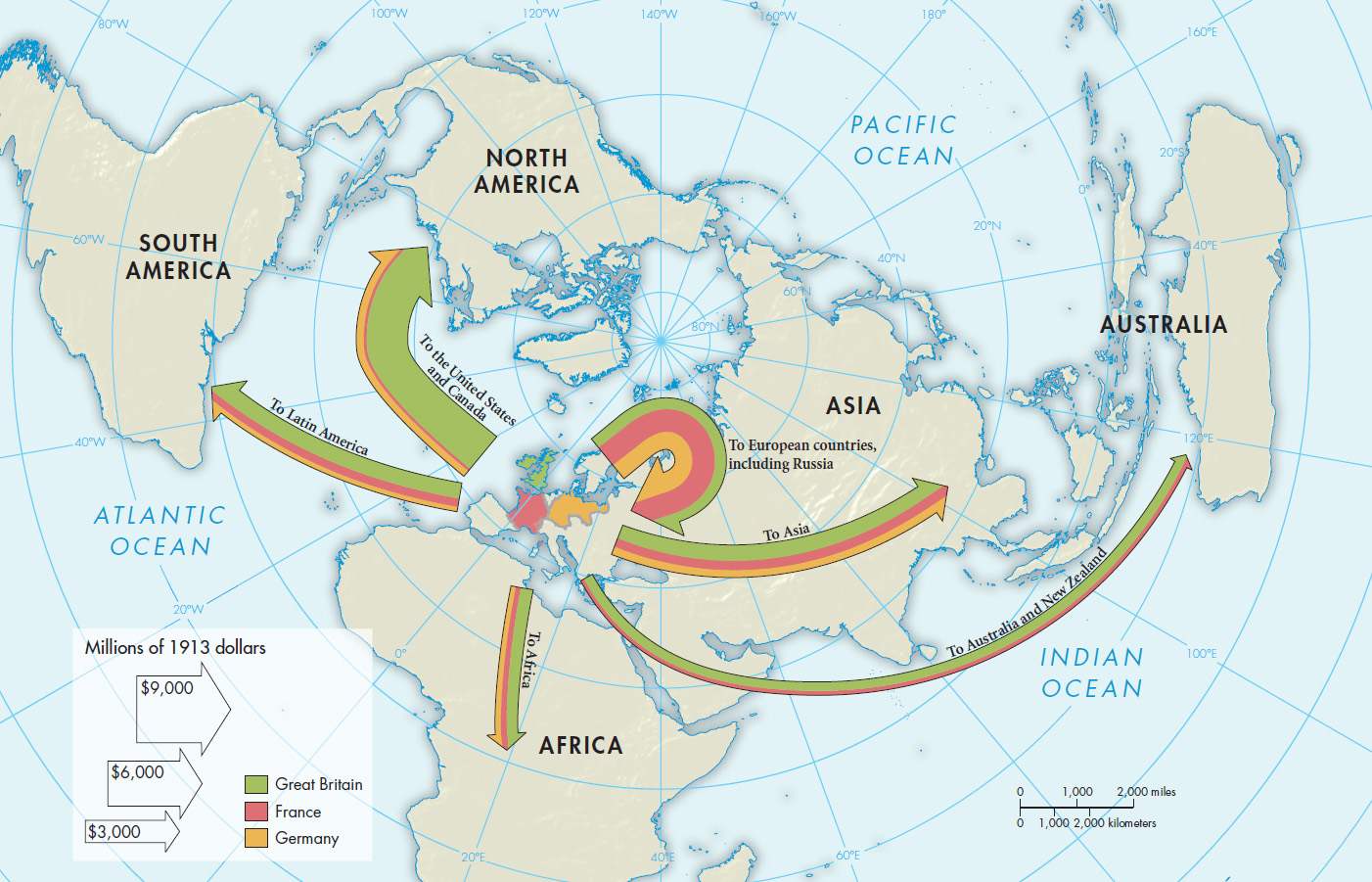The World Market
Commerce between nations has always stimulated economic development. In the nineteenth century Europe directed an enormous increase in international commerce. Great Britain took the lead in cultivating export markets for its booming industrial output, as British manufacturers looked first to Europe and then around the world.
Take the case of cotton textiles. By 1820 Britain was exporting 50 percent of its production. Europe bought 50 percent of these cotton textile exports, while India bought only 6 percent and had its own well-established textile industry. Then as European nations and the United States erected protective tariff barriers to promote domestic industry, British cotton textile manufacturers aggressively sought other foreign markets in non-Western areas. By 1850 India was buying 25 percent and Europe only 16 percent of a much larger volume of production. As a British colony, India could not raise tariffs to protect its ancient, indigenous cotton textile industry, which collapsed, leaving thousands of Indian weavers unemployed.
In addition to its dominance in the export market, Britain was also the world’s largest importer of goods. From the repeal of the Corn Laws in 1846 (see “Liberal Reform in Great Britain” in Chapter 21) to the outbreak of World War I in 1914, Britain remained the world’s emporium, the globe’s largest trader of agricultural products, raw materials, and manufactured goods. Under free-trade policies, open access to Britain’s market stimulated the development of mines and plantations in many non-Western areas.
International trade grew as transportation systems improved. Wherever railroads were built, they drastically reduced transportation costs, opened new economic opportunities, and called forth new skills and attitudes. European investors funded much of the railroad construction undertaken in Latin America, Asia, and Africa, which connected seaports with resource-rich inland cities and regions, as opposed to linking and developing cities and regions within a given country. Thus railroads dovetailed effectively with Western economic interests, facilitating the inflow and sale of Western manufactured goods and the export and the development of local raw materials.
The power of steam revolutionized transportation by sea as well as by land. Steam power began to supplant sails on the oceans of the world in the late 1860s. Passenger and freight rates tumbled as ship design became more sophisticated, and the intercontinental shipment of low-priced raw materials became feasible. The time needed to cross the Atlantic dropped from three weeks in 1870 to about ten days in 1900, and the opening of the Suez and Panama Canals (in 1869 and 1914, respectively) shortened transport time to other areas of the globe considerably. In addition, improved port facilities made loading and unloading cheaper, faster, and more dependable.
The revolution in land and sea transportation encouraged European entrepreneurs to open up and exploit vast new territories around the world. Improved transportation enabled Asia, Africa, and Latin America to ship not only familiar agricultural products — spices, tea, sugar, coffee — but also new raw materials for industry, such as jute, rubber, cotton, and coconut oil. The export of raw materials supplied by these “primary producers” to Western manufacturers boosted economic growth in core countries but did little to establish independent industry in the nonindustrialized periphery.
New communications systems were used to direct the flow of goods across global networks. Transoceanic telegraph cables, firmly in place by the 1880s, enabled rapid communications among the financial centers of the world. While a British tramp freighter steamed from Calcutta to New York, a broker in London could arrange by telegram for it to carry American cargo to Australia. The same communications network conveyed world commodity prices instantaneously.
As their economies grew, Europeans began to make massive foreign investments beginning about 1840. By the outbreak of World War I in 1914, Europeans had invested more than $40 billion abroad. Great Britain, France, and Germany were the principal investing countries (Map 24.1). The great gap between rich and poor within Europe meant that the wealthy and moderately well-to-do could and did send great sums abroad in search of interest and dividends.

Most of the capital exported did not go to European colonies or protectorates in Asia and Africa. About three-quarters of total European investment went to other European countries, or to settler colonies or, neo-Europes — a term coined by historian Alfred Crosby to describe regions that already had significant populations of ethnic Europeans, including the United States, Canada, Australia, New Zealand, Latin America, and Siberia. Europe found its most profitable opportunities for investment in construction of the railroads, ports, and utilities that were necessary to settle and develop the lands in such places as Australia and the Americas. By lending money to construct foreign railroads, Europeans enabled white settlers to buy European rails and locomotives and to develop sources of cheap food and raw materials.
Much of this investment was peaceful and mutually beneficial for lenders and borrowers. The extension of Western economic power and the construction of neo-Europes, however, were disastrous for indigenous peoples. Native Americans and Australian aborigines especially were decimated by the diseases, liquor, and weapons of an aggressively expanding Western society.